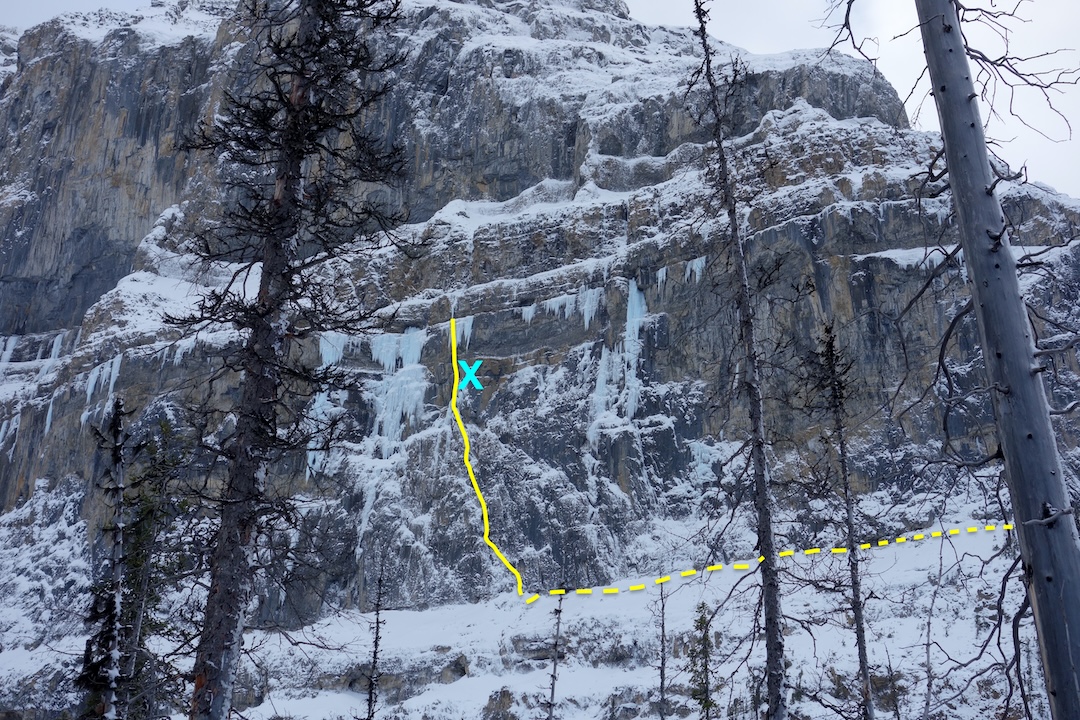Rappel Fatality — Rappel Device Improperly Rigged
Canada, British Columbia, Kootenay National Park and Banff National Park, Stanley Headwll

At the end of 2024, a very experienced climber named Dave Peabody (48) fell to his death while rappelling from a route on the Stanley Headwall. Alik Berg was Peabody’s partner on that day. He wrote to ANAC:
Dave and I had been regular climbing partners for about 12 years with many seasons of winter, alpine, and rock climbing. On December 26 we headed to the Stanley Headwall to climb Drama Queen (170 meters, WI6 M7). This was a fairly routine climbing day for us. That morning we saw teams on French Reality and Dawn of the Dead.
We topped out at dusk (around 5 p.m.) and began rappelling by headlamp. We both used an ATC-Guide on our belay loops and a prusik backup on our leg loops. The last pitch (P4) was the steepest and we climbed on a single rope (blue) with the second rope (red) as a tagline. The pitch was short enough to be rappelled with the blue rope, while red was left fixed at the beginning of the pitch to pull ourselves back in to the anchor atop P3.
This awkward rappel was partly free-hanging, and pulling back in to the belay required care to not disturb a large dripping ice dagger. Dave descended first. I soon joined him. He had already begun setting up the next rappel, threading the red rope through the anchor and joining the two ropes with a single flat overhand knot.
The P3 anchor is a pair of modern bolts with Fixe rap rings. There was enough space on the small ice ledge to not be crowded and we busied ourselves with the routine tasks of rigging the next rappel. I pulled the blue rope, verbally confirming with Dave that the joining knot was in place before making the final tug and pulling up the tail to add a stopper knot. We tied an additional stopper knot in the red rope before tossing it off. We noted that there was a bit of a tangle in the red rope that we’d deal with on the way down.
Dave readied himself to start the rappel. I was distracted with untangling and tossing the remaining rope from the ledge and did not directly observe his connection to the ropes. He started the rappel, moving normally. As Dave descended, my gaze was on the overhand knot joining the rope ends at that moment. I sensed something was off but couldn’t register what it was.
At this point, Dave fell. The interval between sensing something was amiss and when Dave started falling was very short, maybe 1 to 2 seconds or less. There was enough time to register this thought but not enough to assess, let alone react. I believe he was about 5 to 10 meters below the anchor when he fell, not when he first stepped off the ledge and weighted the system.
In the immediate aftermath, I became fixated on something being “off” with the knot and that being the likely point of failure. It wasn’t until reaching the ground the next morning that it became clear that the knot was not the cause of the accident.
When Dave fell, I reacted by grabbing the free-running (red) rope and squeezing hard enough to melt my gloves and burn my fingers, but not enough to slow his fall. In the darkness I could not see him at the base, only the faint glow of his headlamp. It was about 6 p.m.
The team on French Reality had already left the area. The party on Dawn of the Dead had descended, traversed the base of the wall, and were around the corner and out of earshot. About 15 minutes after the accident, their headlamps reappeared as they looped back into view near the valley bottom—about 1 kilometer northwest of my location. I was able to yell down and they turned around. At 6:45 p.m. they reached the base and we could communicate properly. It was then that they realized the severity of the situation and activated their inReach.
Dave and I had both carried a cell phone and an inReach. I had my cell phone but my inReach was at the base, while Dave had been carrying his on the climb. The party below had enough cell reception to make calls with Garmin dispatch and also Parks Canada.
Parks Canada was able to confirm that I was secure on a solid anchor and a good ledge, and was wearing warm clothing. The rescue team decided that given the exposure and technical nature of the location, they would have to wait until sunrise the following morning to mount a rescue.
During the night I acquired sporadic cell reception and in the morning was able to send a few texts to the rescue team, who suggested delivering ropes to me so I could descend on my own. This was a great idea as it eliminated the risk of doing a direct extrication from the steep wall. At 9:20 a.m. a bag containing two ropes and a radio was delivered to me by helicopter long-line. At 9:50 a.m. I was at the base of the route, where I met rescue team members. (Sources: Alik Berg and Parks Canada.)
ANALYSIS
Dave was found with only the blue rope threaded through his device and backup. The device was five to ten meters from the overhand knot.
The matching triple-rated 8.7mm ropes showed no signs of damage, and the joining knot and stopper knots were intact. The stopper knots were unfortunately not photographed, so this comes from the rescuers and my own recollections. However, both parties agreed that the stopper knots were both present.
It appears that Dave’s accident was caused by an improperly threaded rappel device. The simple solution to that is a basic partner or function check. Alternately, rappelling using the stacked rappel method is a solution. It is common in guiding practice and deserves broader adoption in the climbing community.
Though we’ll never know exactly what happened here, these are the scenarios that I’ve come up with:
1. Device and prusik only loaded on blue. During the initial shuffle off the ledge and transition onto steeper ground, both of Dave’s hands were gripping the ropes. Once the ropes were fully weighted, Dave transitioned to a looser grip, perhaps one hand, or maybe he released both to deal with a tangled red rope.
2. Same as above, except the red rope snarled the small ice daggers near the end of P3. They supported his body weight on the initial lower-angle terrain while providing similar tactile feedback to a functioning system. Once on steeper ground, his full weight caused the ice to fail or pulled the rope tangle through the constriction that had held it in place.
3. ATC was properly threaded but prusik backup was attached to the blue rope only. When his hands came off braking, the red rope ran free. The stopper knot was not present and the rope tail ran through the ATC. (Source: Alik Berg.)

